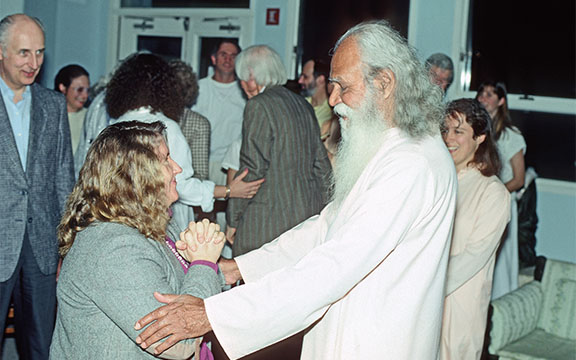
Photo: Parameshwari and Swami Satchidananda, Yogaville Virginia, 1989.
Integral Yoga’s beloved Parameshwari Mary Dinsmoor, an early disciple of Swami Satchidananda (Sri Gurudev), passed away on May 29, 2024, from cancer. Born on Oct. 6,1940, she was a true embodiment of love and selfless service and leaves behind a legacy of devotion, dedication, and inspiration. Our hearts go out to her devoted husband Andy (Parandhaman), their two beautiful sons, Miles (Paramananda) and Scotty (Sadhu), and their beloved grandson William, as well as to all who loved her deeply—and she was loved by so many.
One of the first American students of Swami Satchidananda, she became one of his early secretaries and she also served his many international guests over many years as the talented chef she was. She was an integral part of the Fine Arts Society of Yogaville for many years. She is also well-known as the great memory keeper of Integral Yoga having been a vital part of the organization since its beginnings in America. Thankfully, she shared many of those memories during this interview for the Integral Yoga Archives, which we now share in loving tribute to Parameshwari…
Meeting Swami Satchidananda
I first met Swami Satchidananda on August 1, 1966. My friend Sandy called me and said Peter Max brought a Swami from India. I didn’t know what a Swami was, but I went along. About 35 people were there, and then this gorgeous, tall, thin man in orange robes entered. He began talking about things that had been in my heart all my life. I was 25, had been to Catholic schools, and had left Catholicism because it felt restrictive. Here was this man speaking about love and validating things I had felt intuitively all my life.
Gurudev talked about Hatha Yoga and offered to teach us. He was staying at Peter’s apartment initially, but soon moved to a hotel room at the Oliver Cromwell Hotel. We started Hatha Yoga classes with just a few people, and he charged a dollar per class. Word spread quickly, and soon hundreds of people were coming. The hotel got upset because the lobby was full of people, mostly hippies, but of all ages. A core group formed around him, including Victor Zurbel, Peter Petronio, Yvonne Hannemann, Chuck Soloway, and Conrad Rooks (who had first brought Gurudev to the West).
Establishing the First Center
By October 1966, we found an apartment for Gurudev at 500 West End Avenue, for what was named: the Integral Yoga Institute (IYI). It was a lovely space with a large living room that became the Hatha Yoga room, satsang hall, and everything else. There were two housekeeper’s quarters and two housekeeper’s bathrooms and they became the women’s dressing room and the men’s dressing room and the women and men’s bathrooms. And there was a kitchen that became the kitchen for preparing food and where the office typewriter lived—right on the kitchen table. In the entry hall, we had a little desk and a cash box and that was where you’d sign up for Yoga classes. The first few years there were classes every single day at 10 in the morning and then at 2 p.m., 4 p.m. and 6 p.m.—or something like that. Gurudev taught all of the classes because there were no other teachers. Wednesday nights were for kirtan and Friday nights he gave talks.
In January 1967, Gurudev was to return to Sri Lanka (where he had an ashram at the time) as he had only planned to visit New York for two days on Peter Max’s invitation. We wanted him to stay in America but he was needed there. So, he started training people to teach while he was away. We hoped he would return, but that was uncertain. Garland Jeffrey, who was a lovely, lovely singer, was very involved in the IYI by then. Garland became the kirtan master and knew all the chants and learned all the chanting. So, kirtan continued and Hatha classes continued. After a big letter-writing campaign to try and convince him to return to New York, Gurudev finally agreed to do so.
While Gurudev was away, I had been living in Connecticut and by the time I returned in September, there were hundreds of people attending each class. Gurudev returned to New York and in June 1968, I became his secretary [the term used in India to mean a personal or executive assistant]. By then, we had to move the Friday evening talks Gurudev gave to a larger hall. We chose the Universalist Church, which could hold about 600 people. Every Friday night was packed.
Life as His Secretary
As his secretary, I had a demanding schedule. I started my day at 6 a.m., meditated, and then began preparing meals as well as managing the IYI’s affairs. He was very strict with me, and everything I did was scrutinized. I learned so much from him, not just about managing tasks but about spiritual discipline and patience.
A typical day as Gurudev’s secretary was filled with various responsibilities. I’d type the letters he had dictated the night before and around 9:00 a.m., I’d go to the nearby store to get produce for the day. At 10:00 a.m., the phones would start ringing with people wanting to see him to seek advice, so I would schedule appointments. People would start arriving for Hatha class around that time.
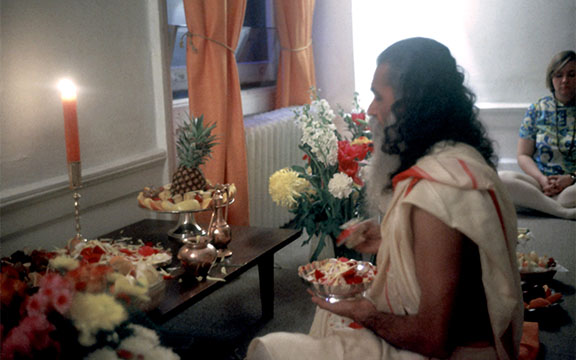
Photo: Gurudev offering puja during mantra initiation; Parameshwari far right, IYI, 1968.
Soon, other Karma Yogis would show up to start the office work of running the IYI. I was constantly screening calls, as well as doing meal prep for Gurudev and others. At noon, we turned off the phones, and the Karma Yogis would meditate, while I finished preparing lunch. In the afternoons, as per Indian tradition, he rested. During that time I would do laundry, clean the kitchen, and manage other tasks. For several hours in the late afternoon, people would come to see him. By 9:00 p.m., after the last class, he’d come into the kitchen, and we’d have tea and talk about the day.
Despite the challenging schedule, I cherished the moments of learning and growth. Gurudev was very patient and loving. He would gently guide us to understand and adopt better and healthier habits without imposing them. His forgiving nature and acceptance of everyone, regardless of where they were on their spiritual journey was beyond inspiring.
Lessons in Humility and Service
One of my favorite things about being able to be close to him was being able to see how he was teaching us. In the beginning of our making many mistakes, he demonstrated so much patience. But as the older, longer time disciples started to learn more, he started expecting more. Gurudev taught us both through his actions and his words. One time he said to me, “I’m going to be very hard on you. If you can’t take it, leave now.” I had no idea what ‘hard’ meant because he had always been so sweet. But from that day on, everything I did was scrutinized. He never praised my efforts but was quick to point out mistakes. It was a challenging period, but it was also a profound learning experience. I learned humility, dedication, and the importance of doing things effectively and efficiently.
Cooking for Gurudev was a part of my duties that I always enjoyed. The secretary before me said he loved spaghetti with ketchup. I was stunned by that and didn’t want to serve him anything of that sort. So, I went to the New York library, found two Indian vegetarian cookbooks, and started creating recipes. Over time, I noticed what he liked and what he didn’t, and I refined the recipes accordingly. When I went to India with Gurudev, I learned more about South Indian cooking from his family and devotees. These recipes became a treasured part of my cooking repertoire for him, and later for his guests, my family and many others.
Spiritual Experiences
There are many, many devotees who have told me stories of healings that they had through Gurudev. One of the most profound experiences I personally had in this regard was during the birth of my first son, Miles. I had left New York to get married and my husband, Parandhaman and I moved to San Francisco. In 1970, when Miles was due I had been planning to have natural childbirth. When I was in labor for 30 hours, the doctors decided on an emergency caesarian due to fetal distress. I asked my husband to call Gurudev. As they wheeled me into the operating room, though no one else seemed to see him, clear as day, I saw Gurudev standing there, assuring me everything would be fine. And it was. This spiritual encounter was profound and confirmed my trust in him.
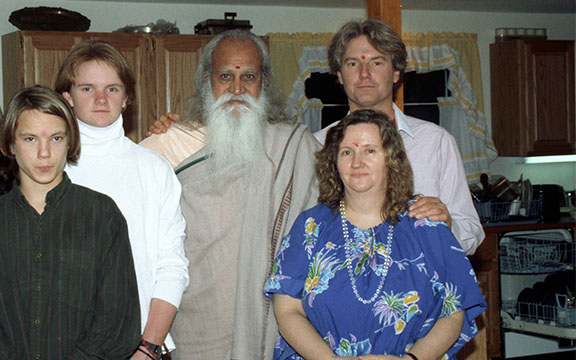
Photo: Dinsmoor family with Gurudev, Yogaville Virginia, circa 1990.
Another time, when we were living in Colorado in 1985, my younger son Scotty had three kidney infections in a row. I thought he was going to die by the third one and I said to my husband, “I have to call Gurudev.” I had no idea where Gurudev was at the time but thankfully, I was able to reach him right away. I was crying and told him that I was afraid Scotty was going to die. Gurudev started reprimanding me for crying and said, “You have to stop that right now. You can’t present a crying, worried face to your child. He’s sick and he needs you to be strong. He needs to know everything is okay and he needs to know he’s safe and he needs to see a smile on your face. Do you understand?
Gurudev made sure I understood all that and then I stopped crying and I was calmed down. At the very end of the conversation Gurudev said, “He’s going to be fine now.” Though I had stopped crying, I still wasn’t totally relaxed until he slipped that in at the very end. And, of course, Scotty was fine and never had another kidney infection after that one! I felt it was a miracle. And I thought to myself, “Why did I wait till he had three? Why didn’t I call Gurudev when he had the first one?!”
A Legacy of Love and Wisdom
Gurudev’s approach to teaching and working with his students was deeply inspiring. He was very accepting of where people were in their lives and spiritual growth. He was especially hard on those who wanted to do the work, but it was always for their growth. I remember one time when Eddie Brigati, who was in the famed band The Rascals, put his arm around Swamiji and said, “Hey Swaj (that’s what he would call Gurudev!), let’s go pick up some girls.” Gurudev laughed and said, “Oh Eddie, you are the naughtiest boy.” Felix Cavaliere, Eddie’s bandmate and also a devotee, asked me why Gurudev didn’t get mad at Eddie, as this seemed really disrespectful. I explained that Eddie didn’t know any better. Gurudev nodded in agreement. Gurudev knew exactly how to handle each person. Eddie went on to become a deeply respectful and lifelong devotee.
I also will never forget one day in Puri during the 1968 India tour. We were a group of American devotees traveling with Gurudev and we wanted to go with him into the main Hindu temple there. The temple officials said because we Americans and were not Hindus we could not enter the temple. Now remember, America in 1968, was filled with many protests by young people. So naturally, a couple of the people on the trip asked Gurudev if we could protest? But, he was not for protesting, though I think he wanted to make a statement to the Hindu temple officials. So he said “You can’t really protest but you can sit here and chant.” For those of us who were more prone to protest, Gurudev was teaching a lesson in how to not protest but peacefully make our case.
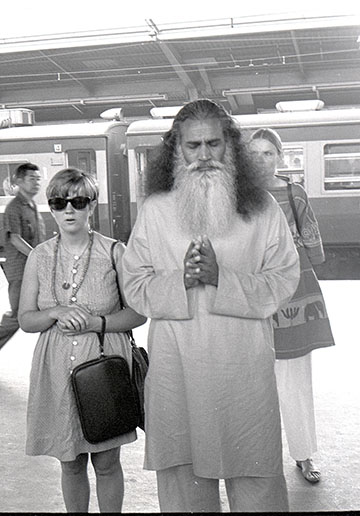
Photo: Traveling with Gurudev in India, 1968.
Though we were not Hindu, we knew how to chant and we wanted them to see that we were humble seekers, very respectful of the Hindu tradition. There were about 18 of us and we all sat down and chanted our hearts out in front of the temple. Gurudev stood there looking like the proud papa as we chanted. We spent the day there and while we chanted, Gurudev went to talk to temple officials. Late in the afternoon the officials came toward Gurudev and us and said, “Okay, you can go in.” Turns out that we were the first non-Hindus ever to be allowed into that temple. I felt that was a huge honor and beautiful experience.
Cultural Lessons and Adjustments
For those of us living at the IYI at that time, it was like a small ashram. Adjusting to the cultural practices and expectations of ashram life was another area where Gurudev’s patience and teaching shone through. We didn’t know how to behave with a Swami initially. We would just launch ourselves onto his bed to chat or discuss plans for the next day. Slowly, he would guide us to change our habits from listening to him while smoking cigarettes and pointing our feet right in his face—all the habits that were just normal for a group of hippies—to treating him more respectfully. He would take the time to explain the reasons behind the various Hindu traditions and how to respect a Guru. It was a gentle and loving process.
As interested as we were to learn his traditions and their meanings, Gurudev was also fascinated by American culture and would ask us lots of questions about our own customs. It was a great delight to go on excursions and watch him discovering America for the first time. He’d been given a car, a white Thunderbird, and he would pile a whole bunch of us in and we’d go on outings—bowling, ice skating—he enjoyed it all. He was very curious about our customs and foods and he loved ice cream and pizza!
The Growth of Integral Yoga
As the Integral Yoga Institute grew, so did the responsibilities. It was a gradual process of taking up all the responsibilities, but the dedication of the community made it possible. Gurudev’s following grew rapidly and the demand for his teachings increased. He started introducing more advanced practices like silent retreats and Raja Yoga classes. He’d been in New York for a little over two years before he even began to teach us Yoga philosophy. And that was a whole new concept for us to realize that Yoga was more than just doing asanas and pranayama.
At first, he taught Raja Yoga once a week and there were maybe 20 or 30 people. Gurudev had not yet written his commentary on the Yoga Sutras, so Gurudev had us use Swami Vivekananda’s book Raja Yoga book and we also used How to Know God, the book on the Yoga Sutras by Swami Prabhavananda and Christopher Isherwood. After about a year those classes really took off and got popular and Gurudev started get some students educated enough so they could teach Raja Yoga classes. When I think about those early days and things he put up with! He had so much patience and shared so much wisdom.
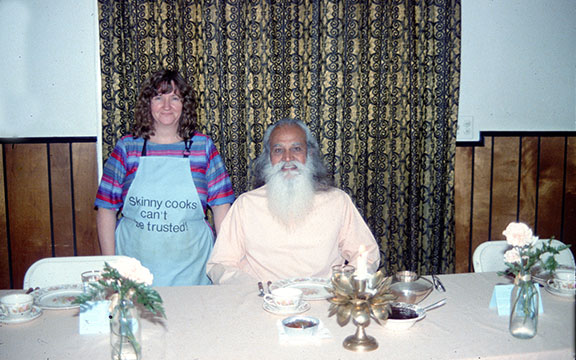
Photo: Parameshwari was the chef during a LOTUS benefit dinner, Colorado, mid-1980s.
A Continuing Legacy
Even after I stopped being Gurudev’s secretary in those early days, my connection with him remained strong. He told me I would always have his number, and he meant it. Whenever I had a family crisis or needed guidance, he was there for me. His teachings and presence were a constant source of strength and comfort. We hosted him in Colorado when we lived there and had seen visited with him in California and various places over the years, but we missed him so much.
In the late 1980s, my husband and I decided to move with our two sons to Satchidananda Ashram in Virginia. I was so happy to have the opportunity to once again be closer to Gurudev and to be of service if possible. I was delighted and honored when he asked if I would like to cook for him again. I began preparing his meals as well as for the many luncheons and dinners we would arrange for he and his guests who would visit him from all around the world. He also asked me to become involved with his beloved Fine Arts Society that Mrs. Rukmini (Amma) Rasiah had begun at his ashram in Sri Lanka and that she and her daughter, Padmarani had begun again at the Virginia ashram where they lived.
Memories and Reflections
From the early days of Hatha Yoga classes in a small hotel room to the packed halls of the Universalist Church, to his Ashram in Virginia, Parameshwari’s journey with Swami Satchidananda was one of growth, learning, and deep spiritual connection. Her stories reflect not only the lasting impact Gurudev had on her and her family’s life, but also the profound impact she has had on the legacy of Integral Yoga.

